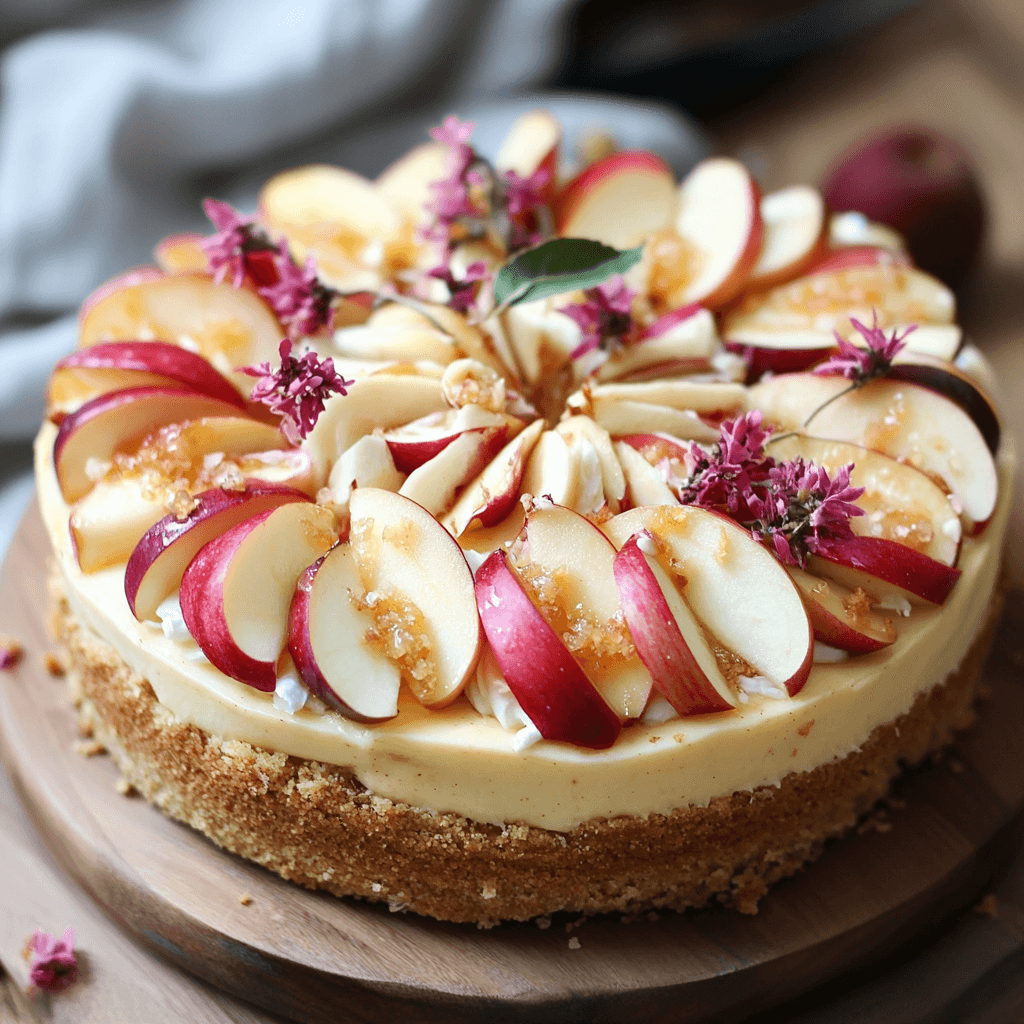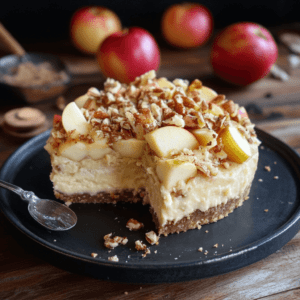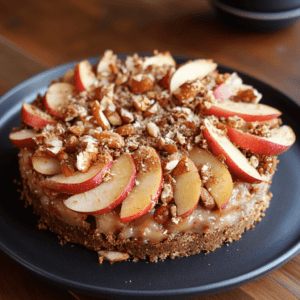Introduction: Why Is Apple Cake Raw?
Baking an apple cake is enjoyable, but encountering an underbaked result can be frustrating. Understanding why your apple cake is raw can help you avoid this issue.
Apple cake is a dessert that marries the sweet, moist richness of a classic cake with the fresh, natural flavors of apples. However, because of the moisture content in apples and the density of the batter, it is particularly susceptible to baking mishaps. From an unevenly baked center to a soggy, raw middle, many factors can affect the outcome of your apple cake.
The good news? These issues are usually preventable. By understanding the causes and remedies for an underbaked apple cake, you’ll be able to bake with confidence and deliver a cake that’s as satisfying to eat as it is to make.
What Does It Mean When a Cake is Raw in the Middle?
A cake that’s raw in the middle is one that hasn’t baked long enough or at the right temperature for the batter to fully set. Baking is a process of heat distribution. The heat from the oven solidifies the structure of the cake while allowing it to rise. If the center remains raw, it typically means that the heat didn’t reach the middle of the cake, or it didn’t stay in the oven long enough to complete the baking process.
A raw center in a cake is more than just disappointing—it can also pose a health risk if the batter contains uncooked eggs, increasing the chance of foodborne illness. Beyond safety concerns, an undercooked, gooey center disrupts the texture and flavor balance of the cake, leaving it overly dense and wet instead of light and enjoyable. This can make the entire baking effort feel like a letdown. To avoid this, ensure even baking by using the right temperature, monitoring doneness with a toothpick or touch test, and making adjustments as needed for consistent results.
Common Reasons for Apple Cake Being Underbaked
Understanding why your apple cake is raw in the middle starts with identifying potential mistakes. Below are some of the most common culprits:
1. Incorrect Oven Temperature Settings
If your oven isn’t calibrated correctly, it could be running hotter or cooler than the temperature you set. This discrepancy can cause uneven baking, where the outside of your cake cooks faster than the inside. A raw center is often the result of an oven that is too hot, causing the edges to bake too quickly while the center remains undercooked.
2. Uneven Heat Distribution in the Oven
Older ovens or ovens with uneven heat distribution can create hot spots. These hot spots may cause one part of your cake to bake faster than the other, leaving some areas undercooked. Using the wrong rack placement can also contribute to uneven baking.
3. Overloading the Cake Batter with Apples
Apples are delicious in cakes, but they are also full of moisture. If you overload your batter with too many apple chunks, the moisture can make it difficult for the cake to set in the center. Additionally, large pieces of apple can weigh down the batter and affect how evenly it bakes.
4. Using the Wrong Type of Baking Pan
The material and size of your baking pan play a significant role in how your cake bakes. Dark or non-stick pans absorb more heat and may cause the edges to cook faster than the center. Similarly, using a pan that is too small for your batter can lead to an overfilled pan that doesn’t bake evenly.
5. Improper Mixing of Ingredients
The way you mix your batter can directly impact its texture and how it bakes. Overmixing can result in a dense batter, while undermixing can leave lumps of flour that prevent the cake from baking evenly.
6. Opening the Oven Door Too Often
It’s tempting to check on your cake as it bakes, but opening the oven door repeatedly causes the temperature inside to drop. This temperature fluctuation interrupts the baking process and can leave the cake raw in the center.
7. Using Too Much Liquid
Aside from apples, other liquids like milk or oil in the batter need to be carefully measured. Adding too much liquid can increase the overall moisture content, making it harder for the cake to bake through.
The Science of Baking: How Heat Affects Cakes
To understand why apple cakes often come out raw in the middle, it helps to know the science behind baking. When exposed to heat, several chemical processes occur in your cake:
- Leavening Agents React: Ingredients like baking powder and baking soda release gases that help the cake rise.
- Proteins Coagulate: The proteins in eggs and flour set the structure of the cake as it bakes.
- Starches Gelatinize: Flour absorbs moisture and forms a stable crumb structure as it cooks.
For these reactions to complete, the heat must penetrate evenly throughout the cake. If the temperature is too low or inconsistent, the center won’t bake properly, leaving it raw and gooey.
Step-by-Step Fixes for Raw Apple Cake
If you’ve baked an apple cake and found it raw in the middle, there’s no need to panic. Follow these steps to fix the problem and salvage your dessert:
1. Check for Doneness
Before removing your cake from the oven, use one or more of these methods to check if it’s done:
- Toothpick Test: Insert a toothpick into the center of the cake. If it comes out clean or with a few crumbs, your cake is done. If it’s wet or sticky, it needs more time.
- Touch Test: Gently press the center of the cake with your finger. If it springs back, it’s done. If it leaves an indentation, it’s underbaked.
- Thermometer Test: Use a food thermometer to check the internal temperature. A fully baked cake should read between 200°F and 210°F.
2. Adjust Baking Time and Temperature
If your cake is consistently raw in the middle, try these adjustments:
- Lower the oven temperature by 10–20°F and bake for an additional 10–15 minutes.
- Use a longer baking time at a lower temperature for dense cakes like apple cake to allow the center to cook through without burning the edges.
3. Cover the Cake with Foil
If the top of your cake is browning too quickly while the center remains raw, cover it loosely with aluminum foil. This prevents the top from burning while the inside continues to bake.
4. Consider Re-Baking
If your cake is out of the oven but still raw, you can put it back in. Place it in the oven at a lower temperature (around 300°F) and bake until the center sets. Cover the edges with foil to avoid overcooking.
Prevention Tips for Perfect Apple Cake Every Time
To avoid future mishaps, follow these preventative measures:
1. Measure Ingredients Accurately
Baking is all about precision. Use a digital kitchen scale to weigh your ingredients instead of relying on volume measurements like cups.
2. Preheat the Oven
Always preheat your oven for at least 15–20 minutes before baking. An improperly preheated oven can result in uneven baking.
3. Use the Right Pan
Choose the correct size and material for your baking pan. For apple cake, a lighter-colored metal pan works best for even heat distribution.
4. Avoid Overloading with Apples
Stick to the recommended amount of apples in your recipe. Too many apples can increase the moisture content and make it harder for the cake to bake evenly.
5. Follow the Recipe
Carefully follow the recipe, paying attention to the mixing instructions and ingredient ratios.
FAQs About Baking Apple Cake
1. How Do I Prevent My Cake From Sinking in the Middle?
To achieve the best results when baking, it’s crucial to ensure your oven maintains a consistent temperature throughout the process. Use an oven thermometer to verify accuracy, as built-in settings can sometimes be unreliable. Additionally, avoid opening the oven door frequently during baking, as this can cause temperature fluctuations that affect the cake’s rise and texture. Another important tip is to avoid overmixing the batter. Overmixing can incorporate too much air, which may cause the cake to deflate as it bakes, leading to a dense or uneven texture. By following these steps, you’ll create a light, fluffy, and perfectly baked cake.
2. Why Does My Cake Burn on the Outside but Stay Raw Inside?
This issue commonly occurs when the oven temperature is set too high. Baking at a high temperature can cause the edges of the cake to cook too quickly while leaving the center undercooked. To fix this, lower the oven temperature to ensure even baking. A lower temperature, such as 325°F, allows the heat to distribute more gradually, giving the center enough time to cook through without overcooking the edges. Extending the baking time slightly will also help achieve a perfectly baked cake with a moist interior and evenly cooked texture.
3. What’s the Best Apple Variety for Baking Cakes?
Granny Smith apples are an excellent choice for baking because their firm texture holds up well during cooking, and their tart flavor provides a perfect balance to the cake’s sweetness. Unlike softer or sweeter apple varieties, Granny Smith apples retain their shape and prevent the dessert from becoming overly mushy or cloyingly sweet. This makes them a go-to option for recipes where you want a contrast of flavors and textures, ensuring your cake is both delicious and well-balanced.
4. Can I Substitute Apples with Other Fruits?
Yes, you can substitute fruits like pears, peaches, or berries in your recipe, but keep in mind that these fruits may affect the overall moisture content and baking time. Pears and peaches, for instance, are juicy and might add extra liquid to the batter, so you may need to reduce other liquids in the recipe slightly. Berries, depending on their size and water content, might require a similar adjustment. Additionally, the added moisture could extend the baking time slightly, so be sure to check for doneness using the toothpick or touch test. With these adjustments, your fruity dessert will turn out delicious and perfectly baked.
5. How Do I Know If My Cake is Fully Cooked Without a Thermometer?
To check if your cake is fully baked, you can use the reliable toothpick test or the touch test. For the toothpick test, insert a clean toothpick into the center of the cake. If it comes out clean or with just a few moist crumbs, your cake is ready. On the other hand, the touch test involves gently pressing the top of the cake with your fingers. A fully baked cake will spring back when lightly pressed, indicating that it is cooked through. Using these simple methods ensures your cake is perfectly baked without overbaking or underbaking.
6. What’s the Ideal Baking Temperature for Apple Cake?
Most cake recipes typically recommend baking at temperatures between 325°F and 350°F. However, if you often find that your cakes are raw or undercooked in the middle despite following the recipe instructions, it might be time to adjust your baking strategy. One effective tip is to bake your cake at a lower temperature, such as 325°F, and extend the baking time. This method ensures that the cake bakes evenly throughout without the edges overcooking or the center remaining uncooked. Lower temperatures allow the heat to penetrate more gradually, resulting in a perfectly baked and moist cake every time. So, the next time you’re troubleshooting an underbaked cake, remember this simple adjustment for better results.
Conclusion: Mastering the Art of Apple Cake
Baking the perfect apple cake requires patience, attention to detail, and a bit of practice. By understanding the common causes of underbaked cakes and implementing the tips and solutions provided in this guide, you’ll be well on your way to achieving consistently perfect results. So go ahead, preheat that oven, and enjoy the delicious rewards of a perfectly baked apple cake.
Related article:
Why is Dutch Apple Cake So Popular?
What is the best cooking apple for cakes?



